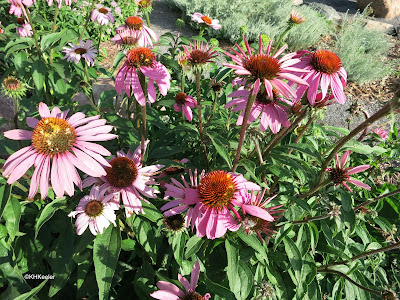 |
| blanket flower Gaillardia aristida |
 |
| aster, Symphyotrichum laeve |
Grasslands stretch across central North America from Texas to Alberta. We call them prairies or the plains or steppe, but until settlement they were one continuous whole, from the forest edge in Kentucky to the base of the Rocky Mountain forests, from the southern end of Alberta's boreal forest to the Gulf of Mexico.
 |
| grasslands of the plains |
North to south, the changes in plants are gradual. If you draw a line north from Texas to Alberta, the south is drier and warmer and the north cooler, with a much shorter growing season, and in those cool conditions, effectively moister. Some plants drop out and others replace them, but some species are found across that whole area.
My eye was drawn to the familiar and there they were, plants I really like, cherished by the Cree as well.
 |
| yarrow, Achillea millefolium |
 |
| fireweed, Chamerion angustifolium |
They won't be identical. Below the obvious similarity lie traits that adapt them to local conditions. If it is cooler or the frosts come in August not September, local plants have to survive these conditions. Thus, my Colorado blanket flower in Alberta would likely grow more slowly than an Alberta blanket flower, expecting more heat and not getting it. Similarly, the Alberta blanket flower will finish flowering and develop its seeds by the time of Alberta's average frost, while the Colorado plant growing there might initiate new buds too late, because in Colorado the killing frost comes later. Sometimes botanists recognize those differences as different species or varieties, but when change is gradual, as in the plains, often no distinction makes sense.
 |
| big clump of Monarda fistulosa, wild bergamot |
I'm not a strong advocate of planting only local plants (genotypes in the jargon) in a native reserve. Natural selection needs genetic diversity so that whatever the conditions, some individuals have the right genes. In central North America especially, there is terrific variation in growing conditions between weeks, months and years. A diverse population is going to do better than a uniform one when (not if) the rare event occurs.
At one time, all of the region was continuous grassland with essentially no barriers. Herds of bison wandered on irregular paths across the region. Seeds that stuck into their hair might go hundreds of miles before falling out, bringing a plant from far away into the local population. Likewise birds or winds carried the occasional seed or pollen grain to a new home across the plains.
 |
| coneflower, Echinacea angustifolia |
So my view is that while local is good, diverse is better. Pragmatically that is replanting with seeds from across the street and adding a handful purchased from a reliable native seed company. If a nearby population no longer exists, the best response is not to despair but to plant diverse enough seed that over time local adaptation can develop.
But more important, my wish, for everyone across the vast plains of central North America, is: plant and cherish native plants. As the Cree garden photographs show, they are gorgeous.
Comments and corrections welcome!
Full disclosure: I said I'd never been as far north as Edmonton. Not precisely: in July 1998 I crossed from Alaska into the southern corner of the Yukon Territory for an afternoon, but I remember lakes and rocks from that trip, not plants.
References
USDA Plants website: plants.usda.gov. to see continuous distributions for these plants.
Kathy Keeler
Join me on Facebook: https://www.facebook.com/AWanderingBotanist



No comments:
Post a Comment